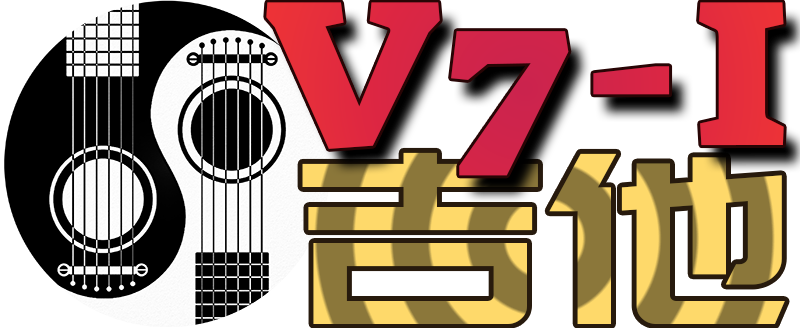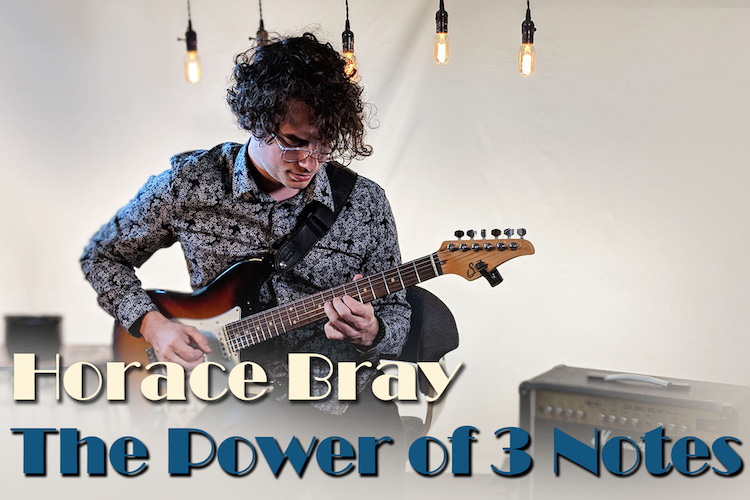时长3小时17分钟。
Lesson 1: The Power of Three Notes Introduction
As guitarists, we tend to memorize shapes without ever really knowing why. The goal of this course is to provide guitarists with the fundamentals to “see” the skeletal structure of the chords and scales they already know, in order to unlock new shapes and sounds. Horace Bray delivers an all-encompassing course on triads; one of the cornerstones of unlocking melody and harmony across the neck.
Lesson 2: Closed G Major Triads for Bottom Strings
Horace gets right to it teaching closed G major triads in all three inversions. You start by focusing on the 6th, 5th and 4th string groupings. These shapes will form the basis moving forward.
Lesson 3: Closed G Major Triads for Middle Strings (5-3)
Horace continues his teaching on the closed G Major triads. Just like the previous lesson, you will learn these shapes for root, 1st and 3rd position. These triads will be on the 5th, 4th and 3rd string group.
Lesson 4: Closed G Major Triads for Middle Strings (4-2)
We continue on the closed G Major triads. Just like the previous lesson, you will learn these shapes for root, 1st and 3rd position. These triads will be on the 4th, 3rd and 2nd string group.
Lesson 5: Closed G Major Triads for Top Strings
And finally, we move to the 3rd, 2nd and 1st strings to finalize our movement across the strings. These will require some practice and memorization before moving to our next lesson.
Lesson 6: Closed Triad G Major Arpeggios
Now that you have learned the G major closed triads across the neck and in all inversions, it's time to apply these as arpeggios. Horace discusses the arpeggio and ways to play them across the neck. The goal is to help you get a grasp of how to connect the individual triads into bigger arpeggios, emphasizing the importance of “using your ear” and how to not get boxed in.
Lesson 7: Open G Major Triads for Bottom Strings
Horace teaches the open G major triad groupings with exercises and examples. Unlike the closed voicing G major triads, the open voicings will cover four instead of three strings. To start you will learn the voicings for the 6th, 5th, 4th and 3rd string group.
Lesson 8: Open G Major Triads for Strings 5-2
Horace continues to teach the open voicing G major triads and the root, 1st and 2nd inversion. This time on the 5th, 4th, 3rd and 2nd string group. We will talk about the different fingerings and ways to practice the shapes.
Lesson 9: Open G Major Triads for Top Strings
And lastly.. you guessed it, triads on the final top strings. Hopefully by now you are beginning to recognize how these are formed, and have been following the advice on how to "get them under your fingers" with provided examples.
Lesson 10: Major Arpeggio Etude
Horace provides a short etude on how to practice connecting the different shapes of the G Major open triads. This helps you visualize the shapes together as well as helps with right hand picking. Use the provided tabs and start slowly!
Lesson 11: Closed A Minor Triads for Bottom Strings
It is time to start looking at minor triad voicings. To get started, Horace will teach the root, 1st and 2nd inversions of the A minor closed triads. Like the G major closed triads, you will start with the 6th, 5th and 4th string group. Reference the provided tabs for your practice sessions.
Lesson 12: Closed A Minor Triads for Middle Strings (5-3)
Lesson 12 picks up the A minor closed triads, now starting on the 5th, 4th and 3rd string group. Just like the previous lesson, you will be learning the closed triad voicings in root, 1st and 2nd inversion.
Lesson 13: Closed A Minor Triads for Middle Strings (4-2)
We move to the next set of strings, with the 4th, 3rd and 2nd. By now, you will start to see the differences between minor and major shapes.
Lesson 14: Closed A Minor Triads for Top Strings
Lesson 14 picks up the A minor closed triads, now starting on the 3rd, 2nd and 1st string group. Be sure to begin comparing these to the major patterns we learned in the last grouping.
Lesson 15: Minor Arpeggio Etude
Finally we use another etude to practice connecting these shapes, and more importantly, the function of each triad across the neck. Refer to the provided tabs for independent practice.
Lesson 16: Open A Minor Triads for Bottom Strings
As you did previously, lesson 16 looks at open voiced triads, this time for A minor. Learn the shapes and fingerings for the root, 1st and 2nd inversion open A minor triads, starting on the 6th, 5th, 4th and 3rd string group.
Lesson 17: Open A Minor Triads for Middle Strings
Lesson 17 continues your learning of the open A minor triad voicings. Learn the root, 1st and 2nd inversion voicings, this time on the 5th, 4th, 3rd and 2nd string grouping.
Lesson 18: Open A Minor Triads for Top Strings
Are you seeing the patterns? Moving to the 4th, 3rd, 2nd and 1st strings, we will again learn the root, 1st, and 2nd inversions.
Lesson 19: Minor Arpeggio Exercise
Now that you have learned the A minor open voicing triads, we transfer that knowledge to open minor arpeggios. Just like with the closed voice, minor triad arpeggios, you will be playing along with Horace to apply what you have learned.
Lesson 20: Closed Triad Pairings
Lesson 20 starts to look at harmonic movement between chords. Using the G major and A minor closed triad voicings, Horace discusses using both of these to create interesting harmonic movement. You will review the shapes, then practice a quick example.
Lesson 21: Open Triad Pairings
Just like the previous lesson, you will now be looking at triad pairs for the open voicings of G major and A minor. Once again, Horace will review the open voiced shapes, then provide examples on how to create harmonic movement with the different triads.
Lesson 22: Change One Note!
Horace introduces the concept of making a single note change to the triad formation to create an entirely new triad. You will be utilizing this concept in the next section of learning for this course.
Lesson 23: G Major Clusters for Bottom Strings
Now that Horace has gone over the 1, 3, 4 cluster in the previous lesson, it's time to start taking a look at these voicings in root, 1st and 2nd inversion. This lesson will start with the 6th, 5th and 4th string group.
Lesson 24: G Major Clusters for Strings 5-3
We pick up the 1-3-4 cluster learning that you started in the previous lesson. Learn the cluster voicings for root, 1st and 2nd inversion, this time for the 5th, 4th and 3rd string grouping.
Lesson 25: G Major Clusters for Strings 4-2
We move to the next set of strings, with the 4th, 3rd and 2nd. By now, you will start to see the differences between minor and major shapes.
Lesson 26: G Major Clusters for Top Strings
Lesson 26 picks up the 1-3-4 cluster learning that you started in lesson 25. Here, we learn the cluster voicings for root, 1st and 2nd inversion, this time for the 3rd, 2nd and 1st string grouping.
Lesson 27: G Major 1-3-4 Arpeggio Connector
To start off, Horace will discuss the 3 note groupings for chords 1, 3 and 4 as well as how to arpeggiate them. He will follow up with a more advanced arpeggio pattern based on the original pattern discussed. Tabs are provided to work through both ascending and descending the lines.
Lesson 28: G Major Open Clusters for Bottom Strings
We take the concepts learned in the previous cluster lessons, but this time from an open 1-3-4 perspective. Horace will provide play along examples to help get these under your fingers.
Lesson 29: G Major Open Clusters for Middle Strings
Horace provides another example of how landing points function within triads.
Lesson 30: G Major Open Clusters for Top Strings
A final example demonstrating this concept. Refer to the provided tab to navigate the fretboard and perfect these concepts.
Lesson 31: Open Cluster Landing Points
Now that we have looked at closed and open cluster voicings in the previous lessons, Horace discusses "Landing Points" for those voicings. He provides examples and discusses the concept.
Lesson 32: A Minor 1-b3-4 Arpeggio
Horace discusses the 3 note groupings for the 1-b3-4 A minor arpeggio. Just like lesson 23 that covers the G major arpeggio, Horace will provide examples to help you with this concept.
Lesson 33: A Minor Clusters for Bottom Strings
Now that Horace has gone over the 1, b3, 4 cluster in the previous lesson, it's time to start taking a look at these voicings in root, 1st and 2nd inversion. This lesson will start with the 6th, 5th and 4th string group.
Lesson 34: A Minor Clusters for Strings 5-3
Lesson 33 picks up the 1-b3-4 cluster learning that you started in the previous lesson. Learn the cluster voicings for root, 1st and 2nd inversion, this time for the 5th, 4th and 3rd string grouping.
Lesson 35: A Minor Clusters for Strings 4-2
We move to the next set of strings, with the 4th, 3rd and 2nd. By now, you will start to see the differences between minor and major shapes.
Lesson 36: A Minor Clusters for Top Strings
Lesson 35 picks up the 1-b3-4 cluster learning that you started on Lesson 33. Learn the cluster voicings for root, 1st and 2nd inversion, this time for the 3rd, 2nd and 1st string grouping.
Lesson 37: Open A Minor Altered Triads for Bottom Strings
In lesson 37, we take the concepts learned in the previous cluster lessons, but this time from an open 1-b3-4 perspective. Horace will provide play along examples to help get these under your fingers.
Lesson 38: Open A Minor Altered Triads for Middle Strings
We continue to work on the 1-b3-4 open cluster examples. Horace provides another example to help hone your skills with this concept.
Lesson 39: Open A Minor Altered Triads for Top Strings
In lesson 39, you continue to work on the 1-b3-4 open cluster examples. Horace provides another example to help hone your skills with this concept.
Lesson 40: Open A Minor Altered Triad Landing Points
Now that we have looked at closed and open cluster voicings for A minor, in the previous lessons, Horace discusses "Landing Points" for those voicings. He provides examples and discusses the concept.
Lesson 41: Combining Elements and Final Thoughts
In lesson 41, Horace wraps up his triad based series with a look at the G major and A minor cluster pairs. He demonstrates and discusses this concept like he did with the open and closed triad pairs.
1.如果遇到其他问题可到问答社区进行提问!“进入问答社区”
2.本站非常重视知识产权,如有侵犯任何第三方权益,请及时联系我们,将及时予与删除!“版权协议点此了解”!


 x
x